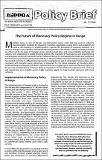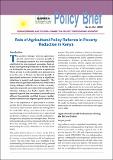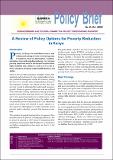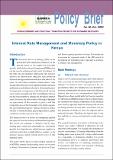Policy Brief No. 17 of 2006 on the Future of Monetary Policy Regime in Kenya
View/
Publication Date
2006Author
Type
KIPPRA Publicationsviews
downloads
Metadata
Show full item recordBy
The Kenya Institute for Public Policy Research and Analysis
Abstract/
Monetary policy is one of the key macroeconomic policy tools that are used to influence macroeconomic variables by regulating monetary aggregates and/or terms and availability of credit in the economy. Its implementation captures the behaviour of monetary authority as it reacts to changes in an economy's macroeconomic environment. The reactions of the monetary authority are influenced by the goals of monetary policy, which include: price and output stability; exchange rate stability and establishing a stable financial system. The mandate of formulating and implementing monetary policy in Kenya is vested in the Central Bank of Kenya. It is mandated to formulate and implement monetary policy to achieve and maintain stability in the general level of prices. Determining how the Bank has reacted over time to different macroeconomic environments, and to what extent these actions were consistent with monetary policy objectives, is important for the future evolution of monetary policy. Understanding how the policy has been implemented, and recognizing the constraints faced, is important for any new monetary policy initiatives. Being an important macroeconomic management tool, achieving and maintaining price stability would enable economic agents to make business decisions with more certainty.
Further Details
This policy brief is based on KIPPRA Discussion Paper No. 58 on Monetary Policy Reaction Function for Kenya, whose objective was to estimate a monetary policy reaction function for Kenya. The study sought to understand whether the Central Bank of Kenya, in its reaction to macroeconomic changes, reacted consistently and in a systematic way or randomly.
Publisher
The Kenya Institute for Public Policy Research and AnalysisSeries
Policy brief No.17 of 2006;Collections
- Policy Briefs [167]
Related items
Showing items related by title, author, creator and subject.
-
Policy Brief No. 6 of 2004 on Role of Agricultural Policy Reforms in Poverty Reduction in Kenya
Kenya Institute for Public Policy Research and Analysis (KIPPRA) (The Kenya Institute for Public Policy Research and Analysis, 2004)This policy brief is based on a study on the Role of agricultural policy reforms in poverty reduction: Implication for economic recovery strategy for wealth and employment creation. The aim of the study is to contribute ... -
Policy Brief No. 9 of 2004 on a Review of Policy Options for Poverty Reduction in Kenya.
Kenya Institute for Public Policy Research and Analysis (KIPPRA) (The Kenya Institute for Public Policy Research and Analysis, 2004)Poverty in Kenya is multidimensional and widespread among all socio-economic groups. It manifests itself in deprivation, isolation, alienation, insecurity and despondency. Low-income poverty manifests itself in the form ... -
Policy Brief No. 10 of 2004 on Interest Rate Management and Monetary Policy in Kenya
Kenya Institute for Public Policy Research and Analysis (KIPPRA) (The Kenya Institute for Public Policy Research and Analysis, 2004)The Economic Recovery Strategy (ERS) for the period 2003-2007 emphasizes on the role of the private sector as the engine for economic growth, while the Investment Programme (2003) points out the need to enhance private ...




